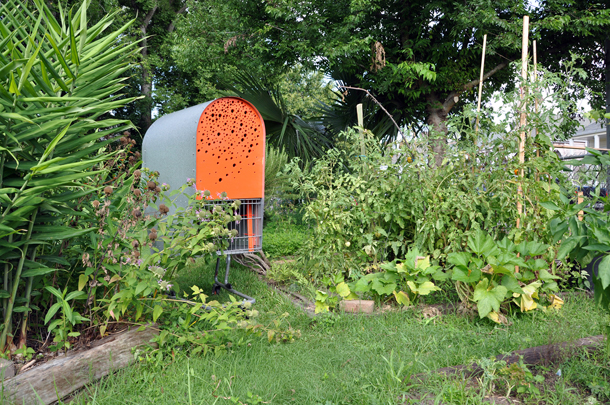2012 Animal Architecture Award Honorable Mention
Cart Coop, Carey Clouse and Zach Lamb
Carey Clouse and Zach Lamb have a long record of animal architecture experiments, from their hand-built bee hives and chicken coops to the conceptual work that earned them recognition in the 2012 Animal Architecture Awards. Crookedworks Architecture is a New Orleans-based architecture-design-build firm focusing primarily on projects addressing urban sustainability and post-disaster cities. For more information on the show and the firm: www.crookedworks.com
The Cart Coop is a prototype chicken coop that elevates an abandoned shopping cart to a replicable model for urban food production.
Abandoned shopping carts have become ubiquitous detritus in the urban realm; littering underused parking lots, streets, and even fragile urban ecosystems. While they vary somewhat in both dimensions and capacity, most carts share the same basic DNA in their core components and shape. This standardization allows for the carts to become an adaptable module for chicken coop construction; one available to any person of any means, in any city in the U.S.
With relatively little effort, shopping carts lend themselves to coop construction. Their modular form can scale up to accommodate a growing flock, or be rearranged to fit a wide variety of spaces. Their sturdy mesh sides provide protection from predators, plentiful ventilation, and positive drainage when the unit is hosed down.
With the use of a few zip ties, and a large sheet of scrap metal, any sort of roof shape can be attached to the shopping cart chassis. While 3’ by 8’ sections of corrugated metal are common freebies in the urban environment, any material or large sheet shape can be used. This sheet material can be fixed to the sides of the cart using zip ties, a rope, or even rivets.
The back plane of the shopping cart detaches easily (it is hinged to allow multiple carts to nest), and this provides a good access point for feeding the chickens and harvesting the eggs. This plane can also be flipped down to meet the ground, allowing the chickens to move in and out of their coop at will.
Stacked boxes or mounted shelves on the interior create laying areas, feeding areas and also a lofted roosting space. The interior of the cart with a raised roof can support up to four chickens.
Chickens are great urban livestock as they are relatively quiet, have limited odor problems, require little maintenance and attention aside from daily feeding, eat kitchen scraps, pick through compost, and scavenge for bugs. While hens should be released into a run during the day, when they spend their nights in the cart, their droppings are distributed on the ground under the cart, performing as a fertilizing chicken tractor.
Because hens lay nearly one egg per day, and their eggs are a great affordable source of protein, they are valuable additions to households and cities. An investment of $1.50 to purchase a young bird and the minimal costs of feeding with free scraps could produce more than 400 eggs over the course of one bird’s lifetime. After that, the same chicken can realize further value as a source of meat.
Shopping carts have long been essential equipment to some of the most resourceful urban citizens, the homeless. The same attributes that make carts valuable as mobile urban storage and transportation (economy, ubiquity, durability, standardization, and mobility), make them the ideal basis for an urban coop. While increasing numbers of urban dwellers are pursuing agricultural activities for environmental, health, and recreational reasons, there is often an inherent tension between the rootedness demanded for food production and the transience of modern urban life. The Cart Coop co-opts the shopping cart to create a movable agricultural infrastructure to fit the demands of mobile urban dwellers.
To plant the seed of the Cart Coop Revolution, we recently led a group of first year college students in making five cart-based coops using materials from willow branches to license plates. In turn, the students went on to teach a Cart Coop building workshop for more than forty urban farmers through the New Orleans Food and Farm Network, a local urban agriculture non-profit organization.
Cart Coop resurrects once-deserted shopping carts into a productive urban asset that has the potential to revitalize food security, health, and independence for urban dwellers of every socio-economic background in cities around the globe. The Cart Coop repurposes one of the most common objects of urban consumer culture in the service of pursuing the self-sufficiency and resourcefulness more commonly associated with rural living.











